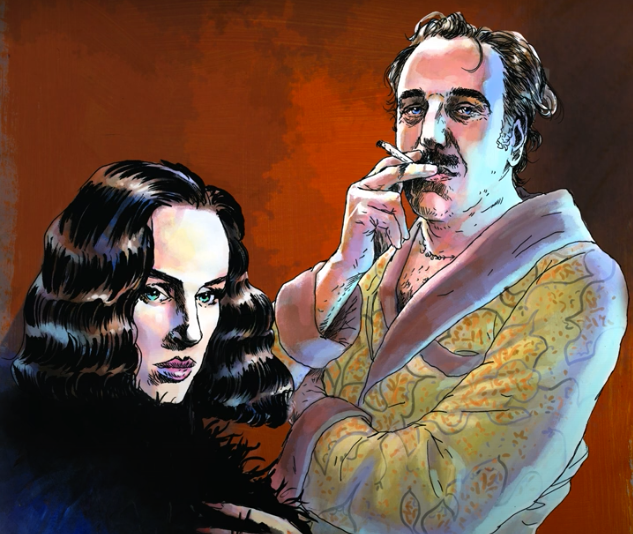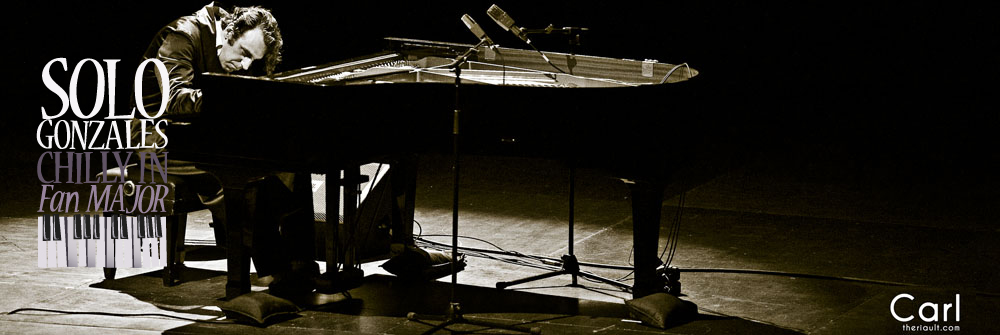 In “I am Europe”, Gonzales’ brilliant lyrics metaphorized major European cities and countries within a catchy Boys Noize soundscape. At the time, having lived in and travelled around Europe for a decade, Gonzales explained that he still had an “outsider” view of European history and culture, and that his lyrics simply reflected what he observed. Fast-forward another decade and Gonzales appears to find himself back in the country that formed the genesis of his ethereal Solo Piano—but this time, he’s not an outsider anymore, having lived about half his life in Europe. He’s not necessarily an insider either but was likely looking for a new challenge that would drive the authenticity that can only stem from a beginner’s mind, and in the case of “French Kiss”, capturing Gonzales’ deep lyrical wit completely in a non-native language (i.e., France” French—as opposed to Quebecois) was likely a formidable—and slightly risky—task.
In “I am Europe”, Gonzales’ brilliant lyrics metaphorized major European cities and countries within a catchy Boys Noize soundscape. At the time, having lived in and travelled around Europe for a decade, Gonzales explained that he still had an “outsider” view of European history and culture, and that his lyrics simply reflected what he observed. Fast-forward another decade and Gonzales appears to find himself back in the country that formed the genesis of his ethereal Solo Piano—but this time, he’s not an outsider anymore, having lived about half his life in Europe. He’s not necessarily an insider either but was likely looking for a new challenge that would drive the authenticity that can only stem from a beginner’s mind, and in the case of “French Kiss”, capturing Gonzales’ deep lyrical wit completely in a non-native language (i.e., France” French—as opposed to Quebecois) was likely a formidable—and slightly risky—task.
We’ll obviously have a thorough review of the album, but seeing as Gonzales released four teaser singles, we thought it would be interesting to take a closer look at one in particular— “Il Pleut Sur Notre-Dame”, or “It’s raining on Notre-Dame”. Obviously referring to the famous French Catholic cathedral, Gonzales and his “featuring” singer Bonnie Banane explore what transpired in April of 2019, when the famous building caught fire, suffering extensive damage. From the initial “singsong” melody to the final bells ringing, the song is an insightful adventure that takes listeners from childhood rhymes to helicopter escapes.
A Sad Rain Falls
The song opens with “Il pleut” sung as a duet between Bonnie Banane and Gonzales, overtop of a melody evocative of classic nursery rhymes such as, “Frère Jacques”, “It’s Raining, It’s Pouring”, and “Ring Around the Rosie”—almost if children are taunting the events transpiring. Here, Gonzales’ baritone registers lower than we’ve ever heard, moving into deeply rich tones that provide a wonderful backdrop on which Bonnie Banane can paint on with her gentle delivery. Their point of view appears to be of a narrator describing the action taking place, first with a single, “it’s raining”, but then repeated with the kicker, “it’s raining on the ashes of Notre-Dame”, and “it’s raining on the people who watch the church burning”. Rain is a very versatile lyrical and literary device, initially creating just the right mood – sadness and despair, but from another point of view, a cleansing force, and finally, one of renewal or new growth “Il Pleut Sur Notre-Dame” deftly uses all three meanings to move listeners from despair to joy and hope for the future.
The singsong piano gives way to a methodical or contemplative background piano rhythm, with Gonzales’ spoken word story overlaid. Here, Gonzales the narrator rhymes “Notre-Dame” with “votre drame”, which translates to “your drama”, but could also mean “your tragedy”; in either case, “your” maintains an outsider’s perspective. The lyrics reinforce the “drama” perspective by indicating that the narrator is seeing the action unfold outside his window, as if he’s watching television or a movie. The line between drama and reality are further blurred through escapism as the narrator lights up a joint (or two) and watches as the smell of smoke from the joint seems to blend with the smoke from the burning building. The smoke here may represent the ambiguous nature of reality, or possibly the narrator thinking the burning church is an illusion—a magician’s trick. Delving even deeper, the conflated smoke could reflect the idea that the church itself is escaping from its own reality, wanting to break free from being confined to other people’s ideas after witnessing 800 years of human behaviour.
Bonnie Banane (who has been providing “ooohs” in the background) returns with Gonzales to repeat the singsong chorus, but the lyrics appear to change slightly to describe how witnesses are mesmerized by the flames. Fire certainly has a natural attraction as humans have likely evolved to prefer being close to fire for survival, but like rain, fire has two sides. Fire represents power and destruction—as in the destruction of ideas, possibly representing the wrath of God. The power to destroy can also be used to guide and purify, giving way for the proverbial Phoenix to rise up and start anew, much like Christianity uses fire to represent rebirth.
Back to the contemplative piano sequence, Gonzales (being Generation X) indicates that nothing generally surprises or touches him, but the seeing the burning church didn’t just wash over him as usual. He appears to think of all the priests that have ceased to be over the years (i.e., died). In the background at the end of the “cease to be”, one can hear a wind noise that may be an exhalation of smoke or the wind representing a snuffing-out of lives—as easily as one snuffs out a candle, of which many were undoubtedly lit in the church over the centuries. The next stanza asks a rhetorical question that reinforces the narrator’s perspective:
Qui a allumé la mèche?
Qui a fait tomber la flèche de bois, de plomb
À travers la nef, d’où tombent les gargouilles en bas-relief
Roughly translated:
Who lit the fuse?
Who made the flèche of wood and lead fall
Through the nave, from which the bas-relief gargoyles fell?
A Tale of Two Pities
At this point, the song takes on two directions. The one that Bonnie Banane runs with is in keeping with the nursery rhyme feel of the song; the perpetrator may in fact have been Quasimodo himself, who loved the church but had to escape after either purposefully or accidentally setting fire to the church. He may have made his hasty exit on via helicopter or speed boat down the river Seine (James Bond style). Somewhat ironically, Victor Hugo, the author of “Notre-Dame de Paris” or “The Hunchback of Notre-Dame”, is credited with saving the gothic architecture of Notre-Dame, which was in danger of being ignored in the face of more modernist “upgrades” to the church, such as replacing dark stained-glass windows with plain opaque windows to “lighten-up” the church. His book renewed interest in ensuring upgrades to the church were in-keeping with original gothic architecture, and after the 2019 fire, several groups who wanted to rebuild the church in a more modern style were shut down in favour of ensuring the church was returned to its original state. Although Hugo fought to preserve the character of Notre-Dame, he fought a battle against the classic formalists to bring about a new Romantic movement revolution in literature. Hugo’s struggle appears to be not unlike Gonzales’ career trajectory in that Gonzales fights to bring elements of classical music to modern ears, while simultaneously battling between entertainer and artist.
While Bonnie Banane leads us on a whimsical story, the narrator leaves on an ambiguous note. One interpretation is that by ignoring or silencing thousands of childhood sexual abuse victims at the hands of priests, the Catholic church itself “lit the fuse” that started the fire. In 1139, as Notre-Dame was being constructed, Catholic priests forcibly lost their human right to marry and have children, requiring them to be unnaturally celibate to demonstrate their unquestioning devotion to God and the church—with potentially unknown downstream impacts. In Hugo’s story, the archdeacon Frollo could not marry and knew that lust was sinful yet lusted over the young Esmeralda with predictably destructive results. The sexual abuse of children is a horrific act that sadly occurs across the globe but is especially heinous within the Catholic church since they knew about the abuse for decades but chose to cover it up instead of openly addressing the issue. The abuse scandal is one of many from the church since Notre-Dame was built, and hundreds of thousands have suffered at the hand of religion over the centuries. From this perspective, the sadness, cleansing, and power to grow anew from rain is apt, while the destruction, spirituality and rebirth from the fire paints a picture of hope that goodness can spring forth from evil and destruction. The shift from darkness to rebirth appears to be represented in Gonzales’ accompanying beautiful shortened video of “Il Pleut Sur Notre-Dame” through the thousands of flowers growing from the ashes within the cathedral.
It’s Raining—Hallelujah!
From when the Bonnie Banane’s Quasimodo lyric starts, the music takes on a more optimistic and lighthearted tone, adding a string synth glissando and piano in a higher register with a wandering sub-bass portamento underscoring the repeated chorus. This time, the cleansing power of rain is highlighted—almost with delight in the sense that the fire is extinguished and the rain is heralding a new era. At the very end of the song, the church bells are optimistically ringing again, representing joy and hope—and possibly that Quasimodo changed his mind and returned to the place he loves and calls home.
“Il Pleut Sur Notre-Dame” is a characteristically brilliant Gonzales composition that moves from darkness to hope, but non-French speakers may need to stretch their brains a bit and hear the beauty and meaning in the words; the music is always beautiful and speaks a universal language that reinforces Gonzales’ message. We’re obviously excited to hear “French Kiss” in its entirety, since album sequencing is always important (even in an on-demand music world).
Like Hugo, Gonzales may be helping to save Notre-Dame by using an outsider point of view to show the church-avoiding French (Catholics in France have the lowest church attendance of all major countries) that they are missing out on an opportunity to acknowledge and right the wrongs of the past and help define the church with modern beliefs, mixing traditional values with messages that resonate and align with modern ears.

Didn’t know that there’s someone taking Chilly Gonzales seriously and writing articles about him ! Keep up the good work (((: Greet from Thailand